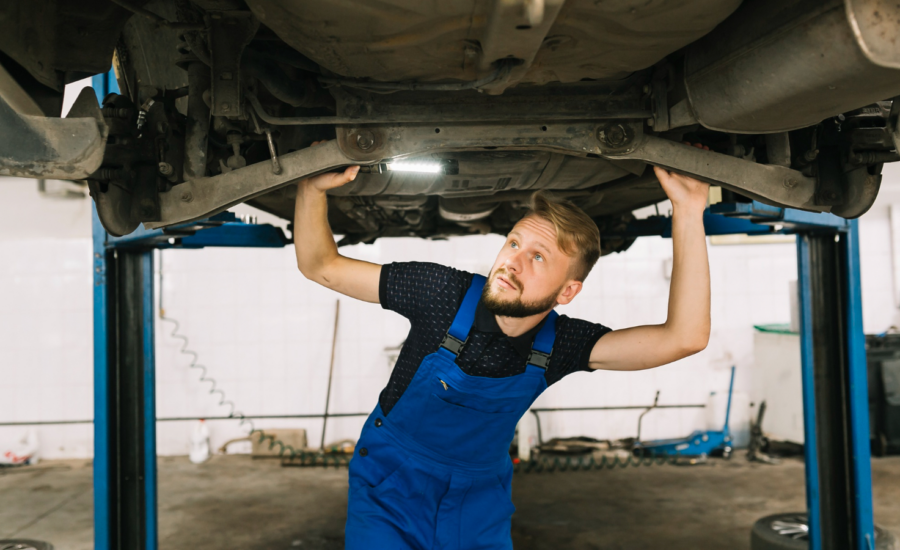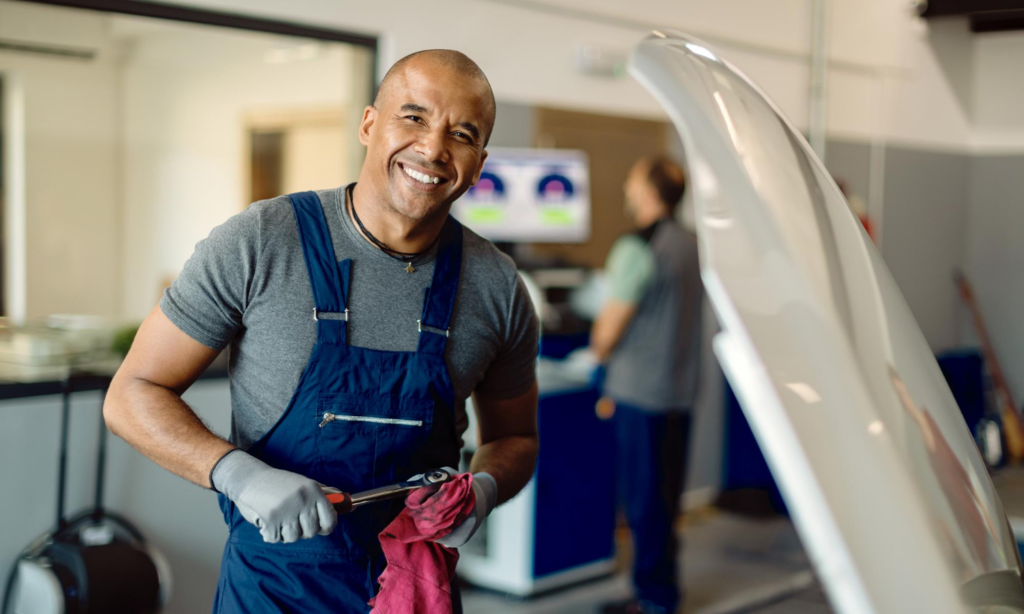Should you take your vehicle to a car repair shop or a dealership?
For some repairs and maintenance, you can bring your ride to any car repair shop or mechanic in Canada. But in some situations, only a dealership will do.
Advertisement
For some repairs and maintenance, you can bring your ride to any car repair shop or mechanic in Canada. But in some situations, only a dealership will do.

Where should you take your car for maintenance and repairs: the dealership, a car repair shop—or somewhere else? The answer: It depends on more questions. What’s broken? How old is your car? Is it a hybrid? Where did you buy it? Is it still under warranty? Is the problem covered by a safety recall, and how do you check? Also, each type of service provider has pros and cons to consider. I’ve summarized them below to share my best advice and help you make an informed decision—and maximize the value you’ll get for your money and time.
If your vehicle has a problem that’s covered by the warranty, the dealership is your best option for repair. Dealership service staff are highly familiar with your vehicle, have completed factory-approved training on it, and have access to its service records, warranty history, repairs, recalls, software updates and a network of other dealerships to consult if needed. Dealerships can also easily access manufacturer-provided data and resources to help effect speedy repairs, even for complex issues.
In under 60 seconds, get matched with a personalized list of loan providers based on your needs and approval likelihood. No SIN required.
Having your car serviced at its dealership helps reduce the chances of certain warranty-related issues, which we’ll dive into later. It also helps ensure your car or truck is up to date on all recalls and software updates, which help it deliver a safer, fully optimized drive.
Of course, you’re free to have your car maintained and serviced wherever you like. Maybe your favourite tire shop handles your seasonal tire change-overs, and you have your oil changed or suspension repaired at a shop near work over your lunch hour. These relatively low-cost maintenance and repair services (and others including brake jobs, air filter changes and exhaust system repair) are widely available at non-dealership repair shops as well, and may be more convenient.
Just remember that, depending on the servicing required, the dealership may be your best or only option. For example, new cars are increasingly built with electronics and systems that require special training and equipment that may only be available at a dealership.

My typical advice to friends and family is to have their vehicle serviced in a dealership setting as often as possible while it’s under warranty, any time a transmission fluid change is required, for any electronics-related trouble, and for any major servicing of an electric vehicle (EV) or hybrid electric vehicle (HEV), and especially for servicing related to its powertrain or electronics. (More on this below.)
Plus, if you service and repair your vehicle exclusively at the dealership, you could benefit from improved resale value and an easier, faster sale down the line—which saves you time and money. That’s because you’ll be able to advertise your car as “dealer-serviced with all records,” which gives potential buyers added peace of mind that servicing, repairs and updates are current, warranty-compatible and backed by the vehicle’s dealer network.
In summary, while you don’t have to service your new vehicle entirely under the dealership’s roof, doing so can help streamline things and save you time. Just remember: If you suspect a warranty-covered problem, contact your dealership first.
According to the J.D. Power Customer Service Index, from 2018 to 2020 inclusive, dealerships captured around 50% of the Canadian market for servicing vehicles that were four to 12 years old. Post-pandemic, they’re capturing a larger share of that market, coming in at 61% in the most recent study. The latest J.D. Power data shows that the average visit to a dealership in 2023 cost $432, while the average visit to an independent shop cost $262—a difference of $170, or about 65%.
Costs at both types of service providers are on an upward trend, with the cost of visiting a dealership growing faster than the cost of visiting an independent car repair shop in recent years. Check out the J.D. Power Customer Service Index and other useful studies on the J.D. Power website.
Some Canadian drivers prefer to take their cars and trucks to independent repair shops and auto mechanics. Especially when it comes to older vehicles that are no longer under warranty, an independent shop can help you maintain your car or truck at a lower cost than its dealership.
Independent shops typically have a lower labour rate than dealerships and can help to save you money by accessing lower-cost parts for certain repairs, though this isn’t always advisable. For instance, use of non-certified parts can put remaining warranty coverage (if applicable) in jeopardy, or cause damage and wear not covered by your car’s warranty.
An independent shop can work on your newer in-warranty vehicle, too, and it may be able to perform certain software updates. For more specialized models or certain types of trouble, an independent shop may point you towards your dealership to have the repair completed, if it’s not able to take care of it.
To find a car repair shop or auto mechanic, check out online reviews and poll your friends and family on their favourite shop. A quick web search can reveal if the shop you’re considering has won any “local favourite” awards, too. Reputable shops will have transparent and clearly displayed pricing, as well as Automotive Service Technician certificates on display for all technicians. In Ontario, for example, you can check a technician’s registration on the Skilled Trades Ontario website.
I recommend to my family members that they service their out-of-warranty vehicles at the independent shop Gregory K & Son Automotive in Sudbury, Ont. We’ve had four vehicles purchased and serviced there over a dozen years. We’ve formed an excellent relationship with its team, and we’re happy with its prices and care.
My advice: Find a shop you like and trust, and stick with it. Having a good relationship with a car repair shop can be great for your peace of mind.
Maybe you drive a specialized car or truck that’s no longer in warranty—something rarer, older and/or exotic. In many cases, vehicles like this have a prominent online owners’ community that’s happy to help new members track down community-recognized experts in their area.
For instance, if you’re trying to service an older Tesla, a high-mileage Toyota Prius, a 12-year-old Hyundai Genesis Coupe, a Mazda Miata convertible or a custom Jeep Wrangler built for off-roading, it can pay to track down the local expert in your area via an online owners’ community. Start by searching or posting in forums or Facebook groups.
A local expert may be a technician at a dealership or an independent tuning or custom shop; an independent mechanic; or a retiree working out of their home’s garage. This local expert is typically highly regarded for their knowledge, but having them perform the work you need could void your remaining warranty coverage (if applicable), which is why this isn’t a popular solution for newer, in-warranty cars.
Note that in the case of certain heavily modified vehicles, the local expert may save you time and money on diagnostics and repair, since dealership technicians are generally trained to work on factory-stock models that haven’t been modified.
Always check references and reviews when considering making that first connection with a local expert. Hopefully, you’ll form a relationship that’ll last years and keep your specialty ride ticking for the long-term.
Wait times and availability
If you just dropped $40,000 or more on a new car or crossover that’s got five or eight or 10 years of warranty, you want to ensure that warranty is protected for its duration.
Key consideration? Your car’s warranty is a two-way agreement: you care for your car a certain way (maintenance) and the warranty coverage applies. New car warranties don’t cover damage caused by a failure to properly service or maintain the vehicle. They also don’t cover damage caused by the use of improper fluids, filters, tools or electronics.
Though rare, anyone servicing your car, regardless of what kind of shop it is, can make a mistake.
Oil-change shop accidentally refill the transmission in your Nissan Rogue with an incompatible fluid? If the transmission fails shortly after, you’re on the hook for the bill since the warranty doesn’t cover transmission damage caused by the use of non-approved fluids.
Accidentally ruin the oil filter gasket while reinstalling it during a DIY oil change? If it leaks and wipes out your engine, that’s a pricey outcome for the same reason. Damaged wiring from an after-market remote-starter install fry your car’s central computer? Guess what: that’s not covered by warranty, either.
My point is: Mistakes like these can cost you a lot of money and put your vehicle’s warranty in jeopardy—unless you get service from your dealership, in which case potential mistakes like these are a problem for the dealership’s bottom line, not yours.
Some vehicles are best maintained and repaired by dealerships, including the ones below. Electrified cars, in particular, are advancing rapidly, and dealers have access to the latest equipment, software, training and equipment to safely work on these vehicles.
Major repairs related to the high-voltage side of the hybrid or electrical system typically require dealer expertise, and even the air conditioning system in some EV models is part of the high-voltage side, necessitating a dealer visit.
These routine maintenance tasks can be completed by just about any private shop.
In some cars, changing out a weak battery is a quick, easy and straightforward job. In others, special equipment is needed to maintain power to vehicle electronics while the batteries are swapped. If your car is one of the latter, removing its battery without connecting that special equipment first can lead to pricey and time-consuming problems, including a tow truck bill. To avoid headaches, check that whoever is changing your battery has access to the proper equipment.
Modern cars with electric parking brakes may require a special electronic tool to send a signal through the vehicle to retract the rear calipers for servicing. Attempting to retract the rear calipers without this specialized tool (and training) can lead to mistakes that might result in a pricey tow bill to a shop for a proper fix. If you’re getting a brake job outside of a dealer setting, ensure the shop has access to the proper electronic equipment. The Electronic Parking Brake (EPB) tool may also be required to bleed brake system fluid, or to reset the braking system after servicing. Attempting a brake job without proper equipment can lead to expensive hassles.
If your car’s windshield is cracked, chipped or damaged, you’ve got numerous choices for repairing or replacing it. Some dealerships can repair glass under their own roof, while others may take your vehicle (or direct you to) a nearby auto glass centre instead. It’s worth calling the dealership to ask if it repairs or replaces windshields in-house. You may be able to save time by going straight to the auto glass centre. Consider checking to see whether a mobile auto glass repair operation is available in your locale, in which case your windshield can be repaired or replaced in your driveway or parking space.
Note that replacing a windshield might mean having to recalibrate some safety features. Lane departure and collision avoidance systems are common in new cars. They often rely on one or more cameras, mounted behind the windshield. When replacing a windshield, reprogramming and relearning these systems are typically required. Technicians use special targets to recalibrate the systems. While many independent shops have these targets, some do not. Checking first can save you time and money.
As with repairing or replacing a windshield, you have options. Your dealership may have the capability to deal with these problems under its roof, or it might point you to another local business that handles this sort of work for them.
As modern cars age, air conditioner problems are some of the most common. While AC problems can have dozens of causes, many tend to be electronic in nature. Thankfully, dealerships and independent car repair shops both have training and equipment to quickly identify and repair AC trouble.
While an in-warranty car should have AC problems addressed by a dealership when possible, most independent car repair shops are well equipped to diagnose and repair even serious AC trouble on most models. It may come down to what you drive. Newer vehicles may require more specialized service and diagnostics, and older vehicles may require harder-to-access parts or refrigerants.
Remember: keeping your vehicle’s cabin air filter clean and fresh can help ensure a longer and more trouble-free life for your vehicle’s air conditioner. Both your dealership or an independent repair shop can replace your cabin air filter if you’re not sure how.
Alternatively, consider saving a few bucks and pulling up a YouTube video to learn how to change this filter yourself—it’s often a very simple job.

Apply for a personal loan with a 8.99% to 29.49% APR. Plus, 100% online application and no early repayment fees.

Apply for a personal loan with a 9.99% to 35.00% APR. Plus, fast e-transfers and no hit to your credit score when you apply.

Apply for a personal loan with a 19.90% to 34.90% APR. Plus, fast funding (as soon as the same business day). Not available in Quebec, PEI, Manitoba, Newfoundland and Labrador, Northwest Territories, Nunavut and Yukon.
Many drivers take their cars to independent repair shops to save a bit of money, but as we’ve covered in detail, in certain situations it makes sense to stick with a dealership—especially for certain kinds of vehicles or if you want to have a consistent service record to make reselling your car or truck easier. Consider it an investment in the future value of your car.
Share this article Share on Facebook Share on Twitter Share on Linkedin Share on Reddit Share on Email